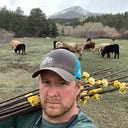Get Grass-Fed beef for $3.60 per Pound
I am giving up one of my little secrets that have helped me to build my cattle herd. For me, this is how I arbitrage the price of beef cattle ranchers get paid vs the price customers will pay for grass-fed beef. The profit I make is enough to make a profit that gets invested in my ranch. But more importantly, it generates cash-flow from cattle that is quick.
I write this from Colorado, so what I have learned is based on my experience here. Each area will be different, but the same rules apply, but results will vary.
I am not worried about giving this information up, because much of it depends on building relationships with ranchers, butchers, and does not rest just on money. I have the connections and relationships in my community because I grew up here and have known most of these ranchers for decades. I trust them, they trust me. Most of my customers do not have the time or interest in developing the network this opportunity requires.
Here is how it works
Ranchers often have cows that they take to the sale barn and sell as “butcher cows” or “butcher bulls.” These are animals that did not get pregnant or got old or some other reason. They are affordable. I pay the market price in this area of Colorado which is $.60 per pound live weight of the animal. (Prices as of July 14, 2019.)
Now. This beef is nearly always 100% grass-fed beef. These cattle have been on pasture their whole lives, and beef ranchers NEVER feed corn to cattle that are just for breeding. Some exceptions depending on were you live; leftover ethanol corn, brewery grains, and other waste products. But in my area, and for most ranchers, butcher animals are never fed anything but grass forges.
Also, these cattle are not given chemicals or drugs because again, those things are expensive, and cattle on pasture are generally healthy.
The most amazing part of butcher animals is their taste. It's like aged wine, the older, the more flavorful. Of course, it's too tough for most steak cuts. But it makes great ground beef, and the tenderloins are out of this world.
There is a lot of room to talk about cuts from old animals. But the ground, tenderloin (filet) offal, and bones are all tasty and wonderful.
The Opportunity
I just took a butcher cow from a long time rancher friend, a man I trust and I know his beef is always on grass. I paid $810 (1350lbs @ $.60) for the animal. The butcher cost the same $810 (coincidence on what he charged for butchering). So I got $1620 into the animal, and will get about 450lbs of meat in the packages. So $3.60 a pound for premier, top-of-the-line grass-fed you cannot get at any store. And those tenderloin roasts, well those are show stoppers at any event!
The Rancher
Ranchers do not like strangers, but they like NOT losing money even more. If you offer market price (contact the sale barn ranchers use and ask about the last average price for butcher cattle). And to pay for the brand inspection, the rancher just got a 15–20% bump in his profit by you offering to pay for market price. The sale barn charges a commission on the sale of his animal, has to pay for a brand inspection, transportation, and time to the sale barn. All of this adds up. You offer to pay market and brand, well you just made his day. You can offer an additional $.05 cents per live weight pound if he hauls it to a butcher of your choosing.
The Butcher
The butcher will make or break the taste of your meat. Call ranchers, small community members, google-search butchers. The smaller, the better flavor and care they will put into your cow. Make sure you direct them to keep the offal. To keep the full tenderloin roast. And give you soup bones.
MOST IMPORTANT! Direct the butcher to only hang for 7 days or lessm(they will know that these means) and to cut out the gland-meat out. So much of ground beef flavor comes from what the butcher throws into the ground. Nearly all the off flavors or gammy-ness comes from the butcher grinding the drying outside meat and gland meat into the ground. Corn-fed beef masks butchers being lazy and grinding everything. My butcher’s heuristic is “If I would not eat it, I do not grind it.”
Conclusion
What I just laid out is how to get awesome grass-fed beef for $3.60 a pound. But as you can see, it takes time, connections, and some risk, especially in the butcher department. Its why I do not care about giving up this info.
The average consumer is not going to take these risks, or learn these lessons. But a few will, and that isgood for the consumer and the rancher, and the small butcher.
But anyone that wants to get into farming or ranching, this is a great way to generate cash flow and customers as you build your new farm. And the ag community (that raises cattle) will welcome you as one of their own. Nothing breeds acceptance like a good commercial transaction that is good for both parties.
You will learn, you will make mistakes. But its the only way to learn and get better beef.
-Joe Hedberg
